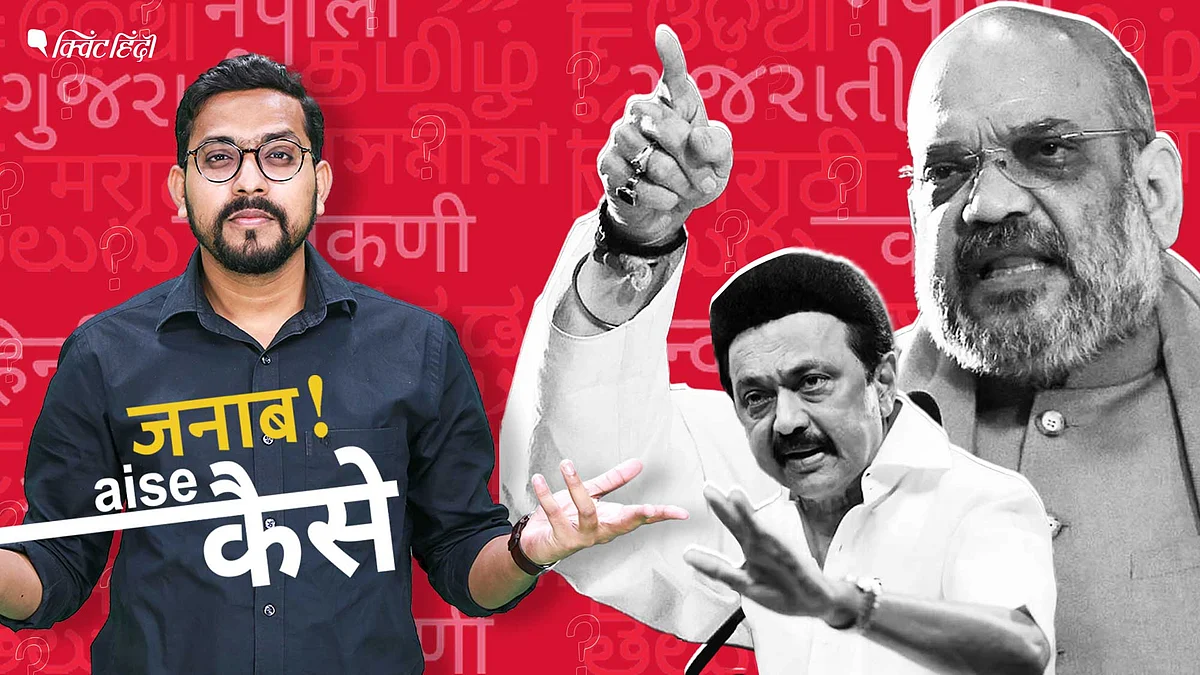The Politics of Language in India: A Battle of Identity and Power
Hindi imposition debates heat up as Tamil Nadu, Bengal & Punjab push back. Who benefits from this language divide?

advertisement
Language in India has always been more than just a means of communication—it has been a tool of identity, politics, and even division. Whether it is Hindi being equated with nationalism, English with elitism, Urdu with religious fundamentalism, or Tamil with South Indian pride, languages in India carry baggage beyond words. Once again, the debate over Hindi imposition has taken center stage, with Tamil Nadu’s DMK government locking horns with the Modi-led central government. But this is not just about Tamil vs. Hindi; it is about how languages are being used as instruments of control, identity assertion, and even marginalization.
The Tamil Nadu vs. Centre Clash
Tamil Nadu has refused to implement the National Education Policy (NEP) 2020, primarily due to the three-language formula, which it perceives as an attempt to impose Hindi on non-Hindi-speaking states. As a consequence, the central government has withheld ₹2,152 crore under the Samagra Shiksha Scheme. Tamil Nadu Chief Minister M.K. Stalin has strongly opposed this move, calling it an attack on federalism and linguistic diversity.
Union Education Minister Dharmendra Pradhan, on the other hand, argues that the NEP 2020 aims to promote Indian languages, and nowhere does it state that Hindi must be made compulsory. However, history shows that such assurances have not always held true in practice.
The Historical Context of Hindi Imposition
The resistance to Hindi imposition is not new. Tamil Nadu has long opposed Hindi’s dominance, with the first anti-Hindi protests dating back to 1937 when the Madras Presidency attempted to make Hindi compulsory in schools. The movement led to mass agitations and even deaths, forcing the policy to be rolled back in 1940. In 1965, another wave of violent protests erupted when the central government attempted to replace English with Hindi as India’s sole official language. This eventually led to the continued use of English alongside Hindi as an official language, as per the Munshi-Ayyangar Formula in the Constitution.
Today, the NEP’s three-language formula has reignited old fears. The formula mandates that students learn their regional language, English, and an additional Indian language (often Hindi in non-Hindi states and a regional language in Hindi-speaking states). However, critics argue that the policy disproportionately pushes Hindi while failing to promote non-Hindi languages in North Indian states.
The Political Undertones of Language Imposition
Language imposition is not merely an educational issue—it is deeply political. The so-called Hindi belt—states like Uttar Pradesh, Bihar, Madhya Pradesh, and Rajasthan—accounts for a significant chunk of India’s parliamentary seats (225 Lok Sabha seats). In the 2019 elections, the BJP won 178 of these seats, and while 2024 saw a dip, the Hindi belt remains its stronghold. The promotion of Hindi as a unifying national language strengthens BJP’s voter base in these regions, reinforcing Hindi’s dominance while sidelining other linguistic identities.
Moreover, Tamil Nadu’s ruling party, the DMK, has historically built its politics around linguistic pride and anti-Hindi sentiments. For the DMK, resisting Hindi imposition is not just about preserving Tamil—it is also an electoral strategy that resonates with its voters.
The Marginalization of Other Languages
While Hindi enjoys state patronage, several other languages—such as Urdu, Bhojpuri, Maithili, and Magadhi—struggle for recognition. For instance, despite being the second official language of Uttar Pradesh, Urdu was excluded from the state assembly’s new multilingual translation initiative. Similarly, Bhojpuri and Maithili, spoken by millions, are often clubbed under Hindi in census data, diminishing their independent status.
The irony is that Hindi itself is not a monolithic language. According to the 2011 Census, only about 43% of India’s population speaks Hindi as their first language. This includes speakers of dialects like Awadhi, Braj, and Khari Boli, many of which have distinct linguistic identities. In states like Bihar and Rajasthan, more people speak Bhojpuri, Maithili, and Rajasthani than Hindi, yet Hindi remains the official language of these states.
Do We Need ‘One Nation, One Language’?
Home Minister Amit Shah once stated that Hindi is the only language that can unify India. But can a country as linguistically diverse as India be bound by a single language? The saying "कोस कोस पर बदले पानी, चार कोस पर वाणी" (Water changes every few miles, and so does language) perfectly captures India’s linguistic diversity. The imposition of one language over others risks alienating non-Hindi speakers and undermines the pluralistic fabric of the nation.
The government’s budget allocations also indicate a bias towards Hindi promotion. In the 2025-26 budget, ₹347.03 crore was allocated for Indian languages, an 11.91% increase from the previous year. However, in 2019-20, ₹50 crore was specifically earmarked for hiring Hindi teachers in non-Hindi states, while no similar allocation was made for promoting South Indian or Northeastern languages in Hindi-speaking states.
The Need for Linguistic Equality
The issue is not about opposing Hindi but about ensuring that no language is placed above others. Language is deeply tied to identity, culture, and history. Forcing a language upon people does not foster unity—it creates resistance.
A truly inclusive linguistic policy would promote multilingualism across the country, ensuring that Tamil, Telugu, Bengali, Punjabi, and other languages receive the same recognition and resources as Hindi. Instead of imposing a single language, India should embrace its linguistic diversity as its greatest strength.
After all, no single colour, cuisine, or attire defines India—why should language be any different?